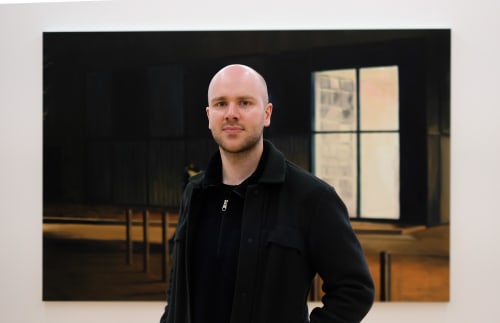I paint everyday scenes based mostly on candid photographs I take of people in the city. My aim is to present and defamiliarize the overlooked, understated, fleeting moments in life, imbuing the everyday with a sense of beauty and grandeur. I have always been drawn to old family photo albums. The moments captured in vernacular photography resonated with me both in terms of their untold stories and the visual quality of analogue photography, with its other-worldly colours, unexpected compositions and softening of details. They seemed to contain an unintended pathos.
Film is another important influence for me in terms of this elevating of everyday subject matter and the telling of untold stories in, for example, the social realism of British kitchen-sink dramas. I am especially interested in pictorial devices, and how these can be used to create a psychological landscape as in the work of directors such as Andrei Tarkovsky and Wong Kar Wai. By making use of such filmic qualities in my work, a narrative is suggested, one that is left open for the viewer to interpret.
In addition to film and photography, the tactility of oil paint has always appealed to me. Oil paint, in the quality of its application, lends itself well to a shorthand expression of detail which helps create ambiguity and an open narrative, inviting the viewer to question what they are looking at, and why the artist wants us to look.
My paintings often depict liminal, transitional spaces or non-places in cities. Anthropologist Marc Augé defines 'non-places' as not relational, historical, or concerned with identity. These spaces have the effect of anonymising and grouping those who inhabit them. We become customers, commuters, workers et cetera.
The 'everyday' is the main theme of my work, with a focus on urban life and the tension between togetherness and isolation these environments. Within this, my paintings gesture towards the ongoing conveyer belt of consumerism: mannequins, supermarket shelves, vending machines, fast food outlets and delivery drivers. I see these as signifiers for the disposable, fast-paced, detached lives we live today.
